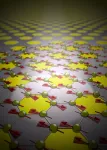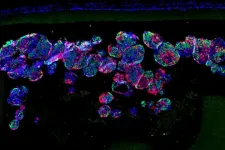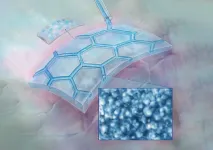Shining light on two-dimensional magnets
New research paves the way to hyper-efficient data storage
2021-06-02
(Press-News.org) Atomically thin van der Waals magnets are widely seen as the ultimately compact media for future magnetic data storage and fast data processing. Controlling the magnetic state of these materials in real-time, however, has proven difficult. But now, an international team of researchers led by Delft University of Technology (TU Delft) has managed to use light in order to change the anisotropy of a van der Waals antiferromagnet on demand, paving the way to new, extremely efficient means of data storage.
The thin atomic layers that make up van der Waals magnets may seem extremely fragile, but they can be about 200 times stronger than steel. Unfortunately, this mechanical strength does not necessarily translate into strong magnetic properties. The reason for this is that, in two dimensions, the magnetic order of these magnets becomes especially vulnerable to heat. Any temperature above the absolute zero (-273 °C) activates random fluctuations in the orientation of the microscopic spins, which can completely collapse the magnetic order. So until we can control their magnetic state, the promises of atomically thin magnets are just that: promises.
Controlling magnetism
The only way to counteract the thermal agitations is to stick magnetic spins more to some directions in the material than to others. Or, as physicists call it: to induce 'magnetic anisotropy'. Doing so makes it harder for spins to change their orientation, thereby lifting their ordering temperature (known as the Curie temperature) way above absolute zero. Controlling anisotropy in low-dimensional magnets, in other words, paves a direct pathway to controlling their ordering temperature and thus the magnetism itself.
In their study the international team, which consisted of researchers from The Netherlands, Spain and Ukraine, used ultrashort pulses of light, a trillion times shorter than a single second, to induce the magnetic anisotropy in a two-dimensional van der Waals antiferromagnet. Why use light? "Because it's a very convenient control knob", Dr. Andrea Caviglia explains. "You can simply and swiftly turn it on and off and therefore manipulate the anisotropy on demand, which is exactly what we need if we want to start using these materials for efficient data storage."
Tuning the color
By systematically varying the color of the light from visible to near-infrared, the scientists also found that not every type of light can generate magnetic anisotropy. To induce this property, the color of light needs to match the energy required to change the orbital state of the electron. That is to say: to change the way electron whirls around a positively charged nucleus. As the electron spin and its orbital motion are tightly linked, the light excitations induce anisotropy, which results in a two-dimensional spin-wave motion. "This motion is coherent - the whole spin ensemble moves in-phase at high frequencies", says Jorrit Hortensius, a PhD student at TU Delft. "This is an elegant and at the same time virtually universal solution to manipulating magnetic anisotropy in practically any two-dimensional magnet."
In this proof-of-principle experiment, the team showed that anisotropy can be photoinduced for a tiny fraction of time, nearly the same as the duration of the light pulse. However, for practical applications the changes to the magnet need to be sustained for a longer period of time. The scientists hope that light pulses with a longer-duration might help to reach this goal. Dr. Dmytro Afanasiev, who currently works at University of Regensburg says: "We hope that longer light pulses can even promote the magnetic order above the equilibrium ordering temperature, so that we can watch in real-time how the ordered state arises from magnetic chaos. This will certainly increase our understanding of magnetism in these van der Waals magnets."
INFORMATION:
[Attachments] See images for this press release:

ELSE PRESS RELEASES FROM THIS DATE:
2021-06-02
In a six-month study of more than 1,000 Americans, R. Kelly Garrett and Robert Bond found that U.S. conservatives were less able to distinguish truth from falsehoods in 20 viral political news stories that appeared online between January and July 2019. Differences in the political orientation of these stories may help explain this observation, the researchers note, writing that "we find that high-profile true political claims tend to promote issues and candidates favored by liberals, while falsehoods tend to be better for conservatives." Two-thirds (65%) of the high-profile true stories were characterized as benefiting the political left, compared with only 10% that were described as benefiting the political right. Among high-profile false stories, 45.8% were perceived to benefit the ...
2021-06-02
Individuals at higher risk of developing pancreatic cancer could be identified earlier using machine learning (ML) techniques which would result in a greater number of patients surviving the disease, suggests a new study published in PLOS ONE.
The study was led by the London School of Hygiene & Tropical Medicine (LSHTM) and funded by the UK charity Pancreatic Cancer Research Fund (PCRF).
It used UK electronic health records for more than 1,000 patients aged 15-99 years who were diagnosed with pancreatic cancer between January 2005 and June 2009.
The researchers examined numerous symptoms and ...
2021-06-02
A team of researchers led by diabetes specialists and biomedical engineers at Washington University School of Medicine in St. Louis and Cornell University has demonstrated that, using a miniscule device, they can implant insulin-secreting cells into diabetic mice. Once implanted, the cells secrete insulin in response to blood sugar, reversing diabetes without requiring drugs to suppress the immune system.
The findings are published June 2 in the journal Science Translational Medicine.
"We can take a person's skin or fat cells, make them into stem cells and then grow those stem cells into insulin-secreting cells," said Jeffrey R. Millman, PhD, an associate professor of medicine at Washington ...
2021-06-02
A new study reveals that B cells can produce antibodies against the H1N1 influenza virus that also neutralize various other influenza strains, marking a development that could inform research into potential universal flu vaccines. The findings showed that the antibodies targeted two conserved regions of the virus - the cause of the 2009 swine flu pandemic - and that transfers of the antibodies protected mice from lethal infection. The work suggests that vaccines that target the two sites might be able to protect against a broader array of flu strains. Influenza is one of humanity's greatest microbial ...
2021-06-02
RICHLAND, Wash.--Scientists have created a cybersecurity technology called Shadow Figment that is designed to lure hackers into an artificial world, then stop them from doing damage by feeding them illusory tidbits of success.
The aim is to sequester bad actors by captivating them with an attractive--but imaginary--world.
The technology is aimed at protecting physical targets--infrastructure such as buildings, the electric grid, water and sewage systems, and even pipelines. The technology was developed by scientists at the U.S. Department of Energy's Pacific Northwest National Laboratory.
The starting point for Shadow Figment is an oft-deployed technology called a honeypot--something attractive to lure an attacker, perhaps a desirable target with the appearance of easy access.
But ...
2021-06-02
A new study from North Carolina State University found that certain types of messages could influence how people perceive information about the spread of diseases from wildlife to humans.
The researchers say the findings, published in the journal Frontiers in Communication, could help scientists, policymakers and others more effectively communicate with diverse audiences about zoonotic diseases and the role of wildlife management in preventing them from spreading to people. Zoonotic diseases are diseases that originate in wildlife and become infectious to people.
"If we want to prevent ...
2021-06-02
A new global review has found that receiving Opioid Agonist Therapy (OAT) is associated with lower risk of multiple causes of death among people with opioid dependence.
The review found that people with opioid dependence were less likely to experience overdose-related, suicide, alcohol-related, cancer, and cardiovascular-related mortality while receiving OAT.
Researchers from the National Drug and Alcohol Research Centre (NDARC) at UNSW Sydney, University of Bristol and several other global institutions reviewed the relationship between OAT and mortality across type of drug, setting and participant groups from over 700,000 participants, which is six times the number of any other previous review.
The review found that mortality risk ...
2021-06-02
Spiders avoid building webs near European fire ants, their natural predators, by sensing the chemicals they give off in the environment, Simon Fraser University researchers have found.
The findings, published recently in Royal Society Open Science, give us a peek inside the enduring struggle between spiders and ants, and could lead to the development of natural repellents for homeowners worried about unwanted eight-legged guests.
Many ants prey on spiders, suggesting that web-building spiders may avoid locations near ant colonies or frequented by foraging ...
2021-06-02
The future of electronic displays will be thin, flexible and durable. One barrier to this, however, is that one of the most widely used transparent conductors for electronic displays--indium tin oxide (ITO)--doesn't perform as well on larger areas and can crack and break down with wear. Indium is also a rare earth mineral, which is relatively scarce, and the process to create ITO requires high energy consumption and expensive equipment.
One emerging alternative is metal "microgrid" conductors. These microgrids can be customized to their application by varying the microgrid width, pitch and thickness, and they can be made with a variety of metals.
New research from the University of Pittsburgh Swanson School of Engineering ...
2021-06-02
Researchers have demonstrated "giant flexoelectricity" in soft elastomers that could improve robot movement range and make self-powered pacemakers a real possibility. In a paper published this month in the Proceedings of the National Academy of Sciences, scientists from the University of Houston and Air Force Research Laboratory explain how to engineer ostensibly ordinary substances like silicone rubber into an electric powerhouse.
What do the following have in common: a self-powered implanted medical device, a soft human-like robot and how we hear sound? The answer as to why these two disparate technologies and biological phenomena ...
LAST 30 PRESS RELEASES:
[Press-News.org] Shining light on two-dimensional magnets
New research paves the way to hyper-efficient data storage



